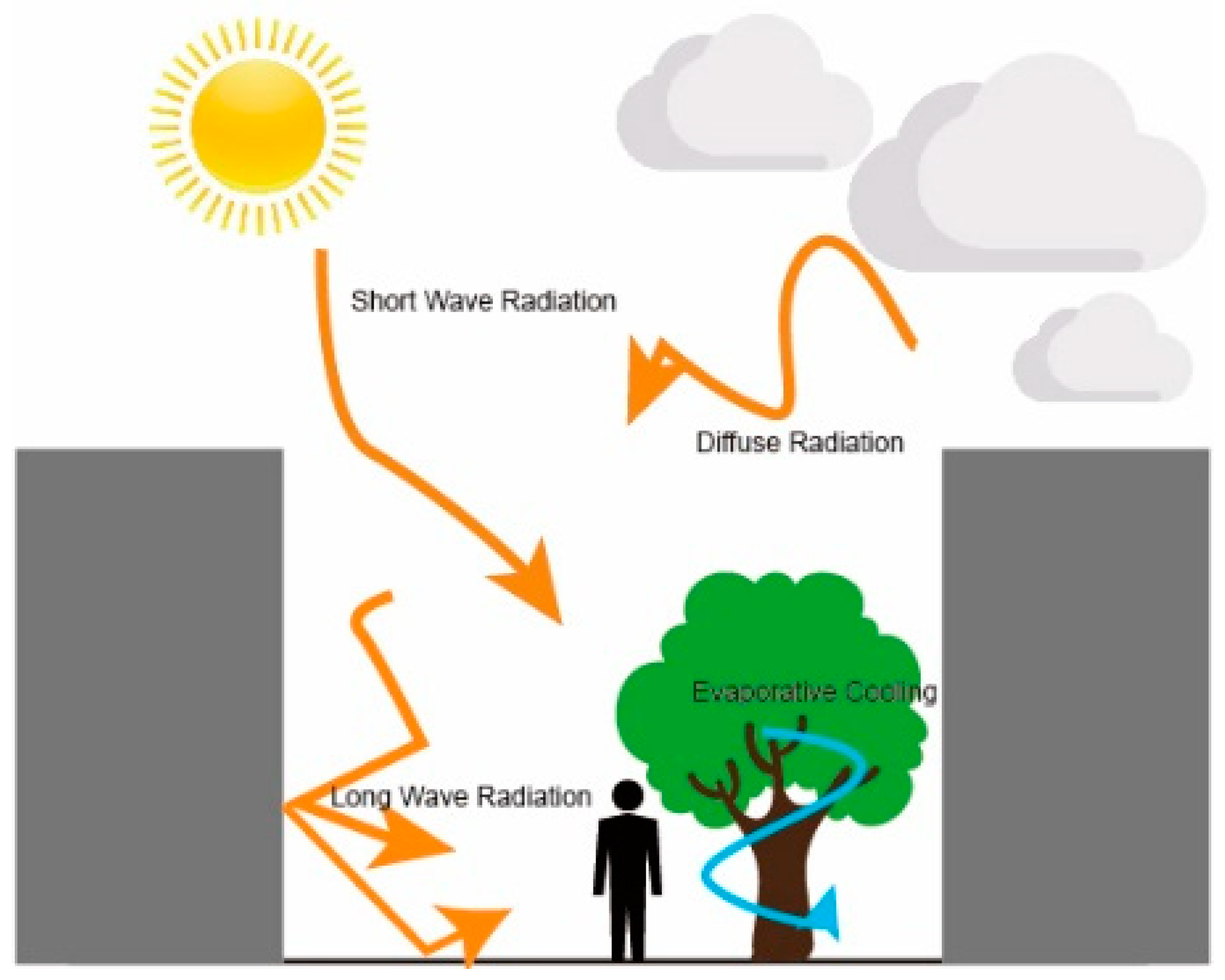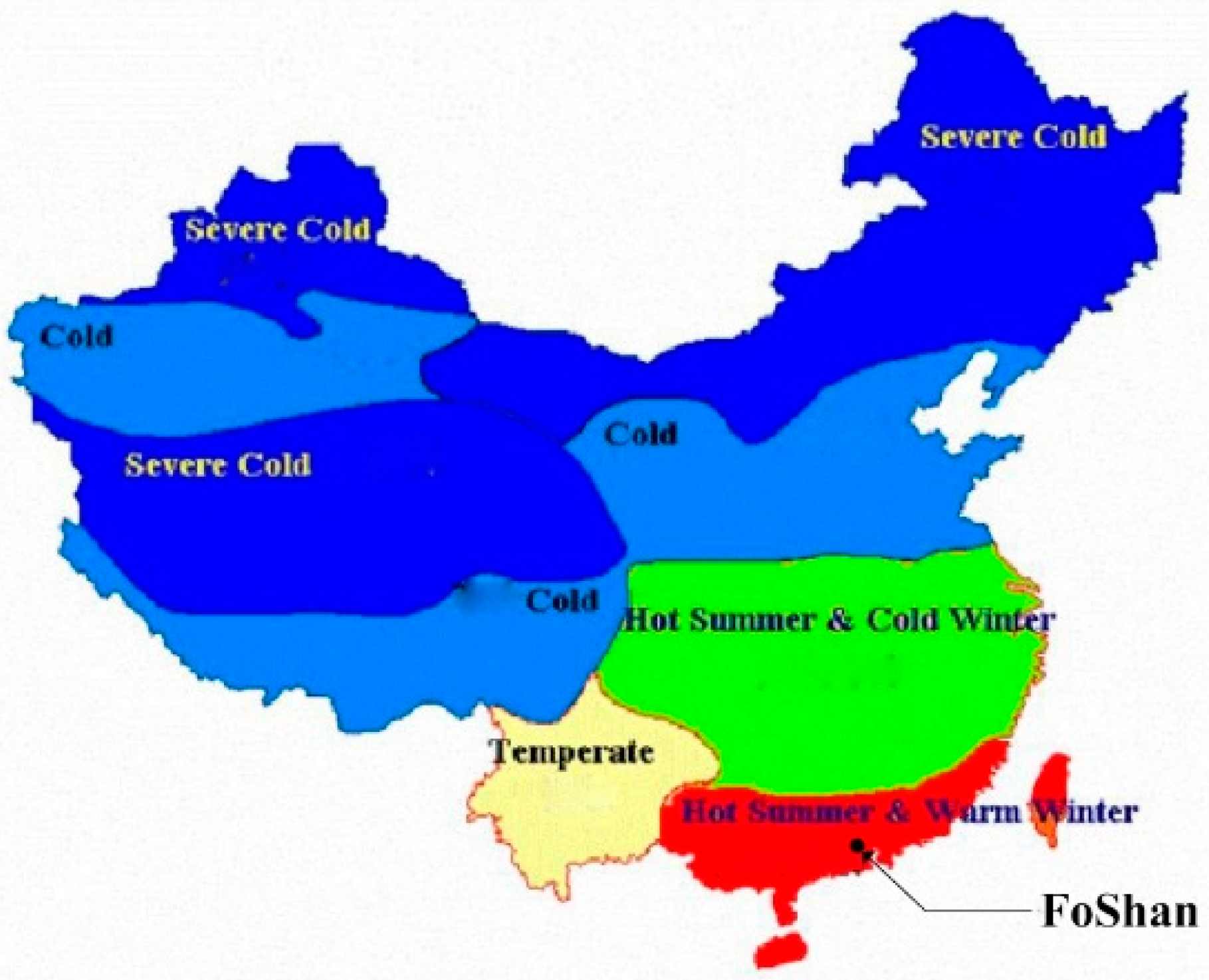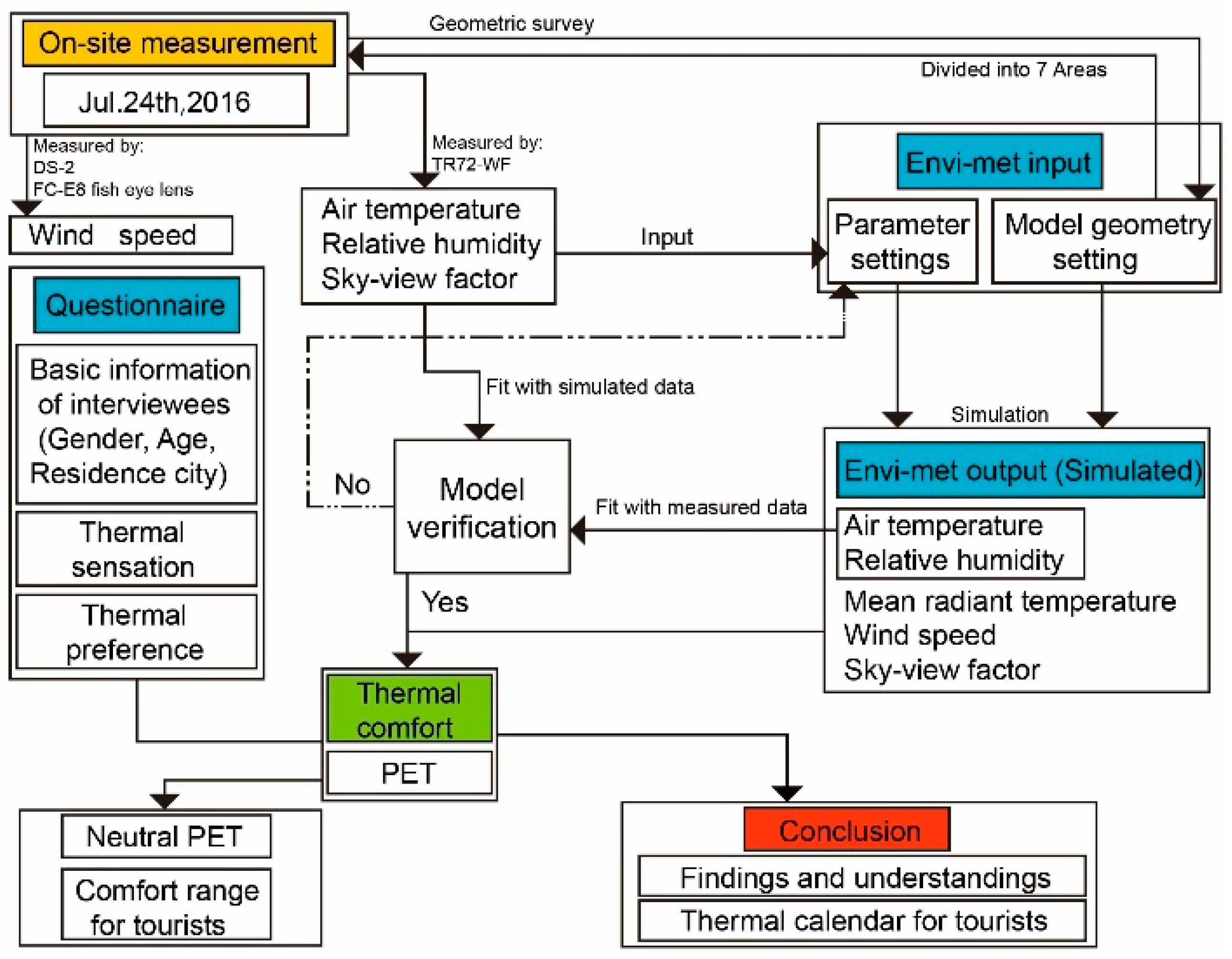A Study of the Pedestrianized Zone for Tourists: Urban Design Effects on Humans’ Thermal Comfort in Fo Shan City, Southern China
Abstract
1. Introduction
1.1. Tourism and Climate
1.2. Development of Thermal Comfort on Tourism
1.3. Thermal Comfort and Urban Public Spaces
2. Methods
2.1. The Research Site
2.2. Methodology
2.3. Field Measurements
2.4. The Questionnaire Survey
2.5. Numerical Simulation of this Study
2.6. The Index for Assessing Thermal Comfort
3. Results
3.1. Questionnaire Survey about Human Thermal Comfort
3.2. The Results of Measurement and Simulation
3.2.1. The Measured Data
3.2.2. The Correlation between Measured and Simulated Data
3.2.3. Tourists’ Thermal Comfort at the Hottest Time of Day
3.3. The Thermal Calendar for Tourists in Extreme Summer
4. Conclusions and Outlook
Author Contributions
Funding
Conflicts of Interest
Appendix A
| Outdoor Thermal Comfort Questionnaire Note: This questionnaire is entirely voluntary. |
|
References
- Matzarakis, A. Weather-and climate-related information for tourism. Tour. Hosp. Plan. 2006, 3, 99–115. [Google Scholar] [CrossRef]
- de Freitas, C.R.; Scott, D.; McBoyle, G. A second generation climate index for tourism (CIT): Specification and verification. Int. J. Biometeorol. 2008, 52, 399–407. [Google Scholar] [CrossRef] [PubMed]
- Bigano, A.; Hamilton, J.M.; Tol, R.S. The impact of climate on holiday destination choice. Clim. Chang. 2006, 76, 389–406. [Google Scholar] [CrossRef]
- Eugenio-Martin, J.L.; Campos-Soria, J.A. Climate in the region of origin and destination choice in outbound tourism demand. Tour. Manag. 2010, 31, 744–753. [Google Scholar] [CrossRef]
- Ridderstaat, J.; Oduber, M.; Croes, R.; Nijkamp, P.; Martens, P. Impacts of seasonal patterns of climate on recurrent fluctuations in tourism demand: Evidence from Aruba. Tour. Manag. 2014, 41, 245–256. [Google Scholar] [CrossRef]
- Lu, S.; Xia, H.; Wei, S.; Fang, K.; Qi, Y. Analysis of the differences in thermal comfort between locals and tourists and genders in semi-open spaces under natural ventilation on a tropical island. Energy Build. 2016, 129, 264–273. [Google Scholar] [CrossRef]
- Matzarakis, A.; Mayer, H. Heat stress in Greece. Int. J. Biometeorol. 1997, 41, 34–39. [Google Scholar] [CrossRef] [PubMed]
- Lecha, L.; Shackleford, P. Climate services for tourism and recreation. Bull. World Meteorol. Organ. 1997, 46, 46. [Google Scholar]
- Mieczkowski, Z. The tourism climatic index: A method of evaluating world climates for tourism. Can. Geogr. Goeogr. Can. 1985, 29, 220–233. [Google Scholar] [CrossRef]
- Shiue, I.; Matzarakis, A. Estimation of the tourism climate in the Hunter Region, Australia, in the early twenty-first century. Int. J. Biometeorol. 2011, 55, 565–574. [Google Scholar] [CrossRef] [PubMed]
- de Freitas, C.R. Tourism climatology: Evaluating environmental information for decision making and business planning in the recreation and tourism sector. Int. J. Biometeorol. 2003, 48, 45–54. [Google Scholar] [CrossRef] [PubMed]
- Yan, Y.Y. Human thermal climates in China. Phys. Geogr. 2005, 26, 163–176. [Google Scholar] [CrossRef]
- Lin, T.P.; Matzarakis, A. Tourism climate and thermal comfort in Sun MoonLake, Taiwan. Int. J. Biometeorol. 2008, 52, 281–290. [Google Scholar] [CrossRef] [PubMed]
- Farajzadeh, H.; Matzarakis, A. Evaluation of thermal comfort conditions in Ourmieh Lake, Iran. Theor. Appl. Climatol. 2012, 107, 451–459. [Google Scholar] [CrossRef]
- Matzarakis, A.; Rammelberg, J.; Junk, J. Assessment of thermal bioclimate and tourism climate potential for central Europedthe example of Luxembourg. Theor. Appl. Climatol. 2013, 114, 193–202. [Google Scholar] [CrossRef]
- Oke, T.R. Street design and urban canopy layer climate. Energy Build. 1988, 11, 103–113. [Google Scholar] [CrossRef]
- Liu, W.; Zhang, Y.; Deng, Q. The effects of urban microclimate on outdoor thermal sensation and neutral temperature in hot-summer and cold-winter climate. Energy Build. 2016, 128, 190–197. [Google Scholar] [CrossRef]
- Chen, H.; Ooka, R.; Harayama, K.; Kato, S.; Li, X. Study on outdoor thermal environment of apartment block in Shenzhen, China with coupled simulation of convection, radiation and conduction. Energy Build. 2004, 36, 1247–1258. [Google Scholar] [CrossRef]
- Zacharias, J.; Stathopoulos, T.; Wu, H. Microclimate and downtown open space activity. Environ. Behav. 2001, 33, 296–315. [Google Scholar] [CrossRef]
- Nastos, P.T.; Matzarakis, A. The effect of air temperature and human thermal indices on mortality in Athens, Greece. Theor. Appl. Climatol. 2012, 108, 591–599. [Google Scholar] [CrossRef]
- Strømann-Andersen, J.; Sattrup, P.A. The urban canyon and building energy use: Urban density versus daylight and passive solar gains. Energy Build. 2011, 43, 2011–2020. [Google Scholar] [CrossRef]
- Taleb, H.; Taleb, D. Enhancing the thermal comfort on urban level in a desert area: Case study of Dubai, United Arab Emirates. Urban For. Urban Green. 2014, 13, 253–260. [Google Scholar] [CrossRef]
- Fröhlich, D.; Matzarakis, A. Modeling of changes in thermal bioclimate: Examples based on urban spaces in Freiburg, Germany. Appl Clim. 2013, 111, 547–558. [Google Scholar] [CrossRef]
- Mochida, A.; Tabata, Y.; Iwata, T.; Yoshino, H. Examining tree canopy models for CFD prediction of wind environment at pedestrian level. J. Wind Eng. Ind. Aerodyn. 2008, 96, 1667–1677. [Google Scholar] [CrossRef]
- Jamei, E.; Rajagopalan, P.; Seyedmahmoudian, M.; Jamei, Y. Review on the impact of urban geometry and pedestrian level greening on outdoor thermal comfort. Renew. Sustain. Energy Rev. 2016, 54, 1002–1017. [Google Scholar] [CrossRef]
- Krüger, E.; Pearlmutter, D.; Rasia, F. Evaluating the impact of canyon geometry and orientation on cooling loads in a high-mass building in a hot dry environment. Appl. Energy 2010, 87, 2068–2078. [Google Scholar] [CrossRef]
- Cao, A.; Li, Q.; Meng, Q. Effects of orientation of urban roads on the local thermal environment in guang zhou city. Procedia Eng. 2015, 121, 2075–2082. [Google Scholar] [CrossRef]
- Zhang, Y.; Du, X.; Shi, Y. Effects of street canyon design on pedestrian thermal comfort in the hot-humid area of China. Int. J. Biometeorol. 2017, 61, 1421–1432. [Google Scholar] [CrossRef]
- Pearlmutter, D.; Berliner, P.; Shaviv, E. Integrated modeling of pedestrian energy exchange and thermal comfort in urban street canyons. Build. Environ. 2007, 42, 2396–2409. [Google Scholar] [CrossRef]
- Morakinyo, T.E.; Lam, Y.F. Simulation study on the impact on tree-configuration, planting pattern and wind condition on street-canyon’s micro-climate and thermal comfort. Build. Environ. 2016, 103, 262–275. [Google Scholar] [CrossRef]
- Morakinyo, T.E.; Kong, L.; Lau, K.K.-L.; Yuan, C.; Ng, E. A study on the impact of shadow-cast and tree species on in-canyon and neighborhood’s thermal comfort. Build. Environ. 2017, 115, 1–17. [Google Scholar] [CrossRef]
- Erell, E.; Pearlmutter, D.; Boneh, D.; Kutiel, P.B. Effect of high-albedo materials on pedestrian heat stress in urban street canyons. Urban Clim. 2014, 10, 367–386. [Google Scholar] [CrossRef]
- Shashua-Bar, L.; Tsiros, I.X.; Hoffman, M.E. A modeling study for evaluating passive cooling scenarios in urban streets with trees. Case study: Athens, Greece. Build. Environ. 2010, 45, 2798–2807. [Google Scholar] [CrossRef]
- Oliveira, S.; Andrade, H.; Vaz, T. The cooling effect of green spaces as a contribution to the mitigation of urban heat: A case study in Lisbon. Build. Environ. 2011, 46, 2186–2194. [Google Scholar] [CrossRef]
- Thimonier, A.; Sedivy, I.; Schleppi, P. Estimating leaf area index in different types of mature forest stands in Switzerland: A comparison of methods. Eur. J. For. Res. 2010, 129, 543–562. [Google Scholar] [CrossRef]
- Miller, J.B. A formula for average foliage density. Aust. J. Bot. 1967, 15, 141–144. [Google Scholar] [CrossRef]
- Zhao, L.; Zhou, X.; Li, L.; He, S.; Chen, R. Study on outdoor thermal comfort on a campus in a subtropical urban area in summer. Sustain. Cities Soc. 2016, 22, 164–170. [Google Scholar] [CrossRef]
- Yang, A.; Juan, Y.; Wen, C.; Chang, C. Numerical simulation of cooling effect of vegetation enhancement in a subtropical urban park. Appl. Energy 2017, 192, 178–200. [Google Scholar] [CrossRef]
- Huang, K.; Li, Y. Impact of street canyon typology on building’s peak cooling energy demand: A parametric analysis using orthogonal experiment. Energy Build. 2017, 154, 448–464. [Google Scholar] [CrossRef]
- Hamada, S.; Ohta, T. Seasonal variations in the cooling effect of urban green areas on surrounding urban areas. Urban For. Urban Green. 2010, 9, 15–24. [Google Scholar] [CrossRef]
- Saito, I.; Ishihara, O.; Katayama, T. Study of the effect of green areas on the thermal environment in an urban area. Energy Build 1990, 15, 493–498. [Google Scholar] [CrossRef]
- Katayama, T.; Ishii, A.; Hayashi, T.; Tsutsumi, J. Field surveys on cooling effects of vegetation in an urban area. J. Therm. Biol. 1993, 18, 571–576. [Google Scholar] [CrossRef]
- Cultural Heritage and Tourism Organization of Fo Shan. Available online: http://www.foshan.gov.cn/gzjg/fswenhua/lydt/ (accessed on 1 April 2019).
- TDCFCB. Thermal Design Code for Civil Buildings, GB 50176–51993. Available online: https://zhidao.baidu.com/question/492628757.html (accessed on 1 April 2019).
- Kottek, M.; Grieser, J.; Beck, C.; Rudolf, B.; Rubel, F. World map of the Köppen-Geiger climate classification updated. Meteorol. Z. 2006, 15, 259–263. [Google Scholar] [CrossRef]
- Meteorological Organization Country. Available online: http://www.irimo.ir (accessed on 1 January 2019).
- ISO. International Standard 7726, Thermal Environment-Instruments and Method for Measuring Physical Quantities; International Standard Organization: Geneva, Switzerland, 1998. [Google Scholar]
- Sharmin, T.; Steemers, K.; Matzarakis, A. Analysis of microclimatic diversity and outdoor thermal comfort perceptions in the tropical megacity Dhaka, Bangladesh. Build. Environ. 2015, 94, 734–750. [Google Scholar] [CrossRef]
- Lai, D.; Guo, D.; Hou, Y.; Lin, C.; Chen, Q. Studies of outdoor thermal comfort in northern China. Build. Environ. 2014, 77, 110–118. [Google Scholar] [CrossRef]
- Lin, T. Thermal perception, adaptation and attendance in a public square in hot and humid regions. Build. Environ. 2009, 44, 2017–2026. [Google Scholar] [CrossRef]
- Yang, B.; Olofsson, T.; Nair, G.; Kabanshi, A. Outdoor thermal comfort under subarctic climate of north Sweden—A pilot study in Umeå. Sustain. Cities Soc. 2017, 28, 387–397. [Google Scholar] [CrossRef]
- Standard 55. Thermal Environment Conditions for Human Occupancy; Amer Society of Heating: Atlanta, GA, USA, 2013. [Google Scholar]
- Villadiego, K.; Velay-Dabat, M.A. Outdoor thermal comfort in a hot and humid climate of Colombia: A field study in Barranquilla. Build. Environ. 2014, 75, 142–152. [Google Scholar] [CrossRef]
- De Dear, R.J.; Brager, G.S. Thermal comfort in naturally ventilated buildings: Revisions to ASHRAE Standard 55. Energy Build. 2002, 34, 549–561. [Google Scholar] [CrossRef]
- Bruse, M. ENVI-met, 2014, 4. Available online: http://www.ENVI-met.info (accessed on 1 January 2019).
- Middel, A.; Häb, K.; Brazel, A.J.; Martin, C.A.; Guhathakurta, S. Impact of urban form and design on mid-afternoon microclimate in Phoenix Local Climate Zones. Landsc. Urban Plan. 2014, 122, 16–28. [Google Scholar] [CrossRef]
- Fanger, P.O. Thermal Comfort; McGraw Hill: New York, NY, USA, 1972. [Google Scholar]
- Gagge, A.P.; Fobelets, A.P.; Berglund, L.G. A standard predictive index of human respond to the thermal environment. Ashare Trans. 1986, 92, 709–731. [Google Scholar]
- De Dear, R.; Pickup, J. An outdoor thermal environment index (OUT_SET*)-applications. In Biometeorology and Urban Climatology at the Turn of the Millenium, Proceedings of the ICB-ICUC’99 Conference, Sydney, Australia, 8–12 November 1999; de Dear, R.J., Kalma, J.D., Oke, T.R., Auliciems, A., Eds.; WCASP-50, WMO/TD No. 1026; World Meteorological Organization: Geneva, Switzerland, 2000. [Google Scholar]
- Spagnolo, J.; de Dear, R.J. A field study of thermal comfort in outdoor and semi-outdoor environments in subtropical Sydney Australia. Build. Environ. 2003, 38, 721–738. [Google Scholar] [CrossRef]
- Mahmoud, A.H.A. Analysis of the microclimatic and human comfort conditions in an urban park in hot and arid regions. Build. Environ. 2011, 46, 2641–2656. [Google Scholar] [CrossRef]
- Höppe, P. The physiological equivalent temperature—A universal index for the bio-meteorological assessment of the thermal environment. Int. J. Biometeorol. 1999, 43, 71. [Google Scholar]
- Xu, C.; Li, S.; Zhang, X.; Shao, S. Thermal comfort and thermal adaptive behaviours in traditional dwellings: A case study in Nanjing, China. Build. Environ. 2018, 142, 153–170. [Google Scholar] [CrossRef]
- Nikolopoulou, M.; Baker, N.; Steemers, K. Thermal comfort in outdoor urban spaces: Understanding the human parameter. Sol. Energy 2001, 70, 227–235. [Google Scholar] [CrossRef]
















| Point | Characteristic | Surface | Shade | Aspect Ratio (H/W) |
|---|---|---|---|---|
| 1 | NW-SE direction | Paving granite | √ | 1.25 |
| 2 | N-S direction | Paving granite | - | 1.25 |
| 3 | NW-SE direction | Paving granite | √ | 1.5 |
| 4 | Open space | Brick | - | 0.2 |
| 5 | NW-SE direction | Paving granite | √ | 0.5 |
| 6 | NE-SW direction | Paving granite | √ | 1 |
| 7 | Open space | Paving granite | √ | 0.25 |
 | Point | Photo | Plane | Section |
| 1 |  |  |  | |
| 2 |  |  |  | |
| 3 |  |  |  | |
 | 4 |  |  |  |
| 5 |  |  |  | |
| 6 |  |  |  | |
| 7 |  |  |  |
| Variable | Sensor | Accuracy | Range | Interval | Mode |
|---|---|---|---|---|---|
| Relative humidity | TR-72wf | ±5% | 10–95% | 1 min | Automatic |
| Air temperature | TR-72wf | ±0.5 °C | 0–±55 °C | 1 min | Automatic |
| Anemoscope | DS-2 | ±0.3 m/s | 0–70 m/s | 1 min | Automatic |
| Input for Simulation | Value |
|---|---|
| Starting time | 12:00 a.m., 24 July 2016 |
| Total simulation time | 24 h |
| Wind speed in 10 m (m/s) | 1.8 |
| Wind direction | 145 |
| Initial air temperature (°C) | 37 |
| Relative humidity (%) | 55 |
| Roughness length | 0.1 |
| No. of x grids | 200 |
| No. of y grids | 100 |
| No. of z grids | 30 |
| Grid of dx (m) | 3 |
| Grid of dy (m) | 3 |
| Grid of dz (m) | 3 |
| Albedo ground | 0.4 |
| Albedo roof | 0.2 |
| Albedo wall | 0.3 |
| Point | 1 | 2 | 3 | 4 | 5 | 6 | 7 |
|---|---|---|---|---|---|---|---|
| No. | 35 | 36 | 31 | 42 | 35 | 30 | 32 |
| Sensation | PET (°C) |
|---|---|
| Very cold | <13 |
| Cold | 13–17 |
| Cool | 17–21 |
| Slightly cool | 21–25 |
| Neutral | 25–29 |
| Slightly warm | 29–33 |
| Warm | 33–37 |
| Hot | 37–41 |
| Very hot | >41 |
| Point | 1 | 2 | 3 | 4 | 5 | 6 | 7 |
|---|---|---|---|---|---|---|---|
| 24 July | 0.43 | 0.54 | 0.35 | 0.32 | 0.27 | 0.32 | 0.35 |
© 2019 by the authors. Licensee MDPI, Basel, Switzerland. This article is an open access article distributed under the terms and conditions of the Creative Commons Attribution (CC BY) license (http://creativecommons.org/licenses/by/4.0/).
Share and Cite
Ma, X.; Fukuda, H.; Zhou, D.; Wang, M. A Study of the Pedestrianized Zone for Tourists: Urban Design Effects on Humans’ Thermal Comfort in Fo Shan City, Southern China. Sustainability 2019, 11, 2774. https://doi.org/10.3390/su11102774
Ma X, Fukuda H, Zhou D, Wang M. A Study of the Pedestrianized Zone for Tourists: Urban Design Effects on Humans’ Thermal Comfort in Fo Shan City, Southern China. Sustainability. 2019; 11(10):2774. https://doi.org/10.3390/su11102774
Chicago/Turabian StyleMa, Xuan, Hiroatsu Fukuda, Dian Zhou, and Mengying Wang. 2019. "A Study of the Pedestrianized Zone for Tourists: Urban Design Effects on Humans’ Thermal Comfort in Fo Shan City, Southern China" Sustainability 11, no. 10: 2774. https://doi.org/10.3390/su11102774
APA StyleMa, X., Fukuda, H., Zhou, D., & Wang, M. (2019). A Study of the Pedestrianized Zone for Tourists: Urban Design Effects on Humans’ Thermal Comfort in Fo Shan City, Southern China. Sustainability, 11(10), 2774. https://doi.org/10.3390/su11102774





